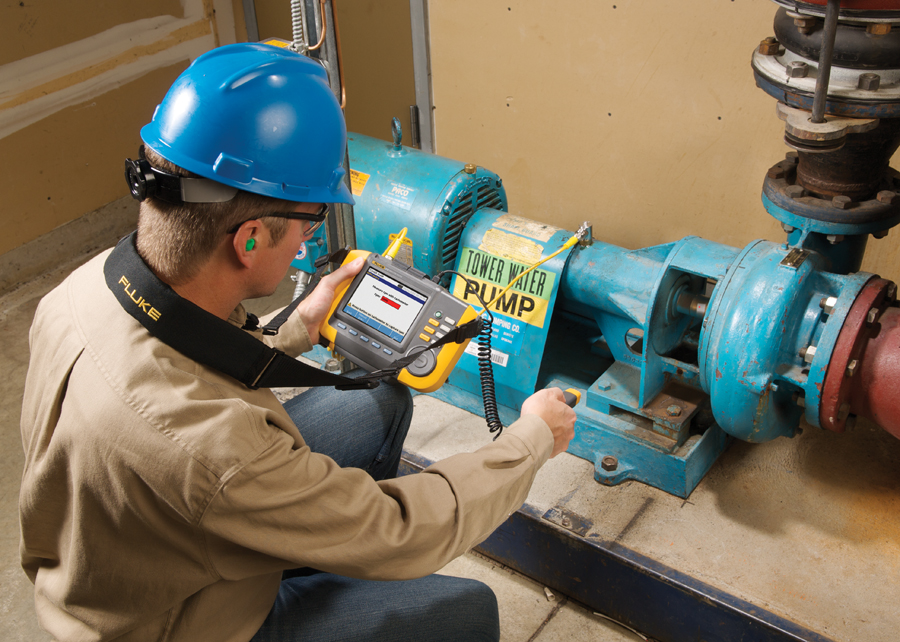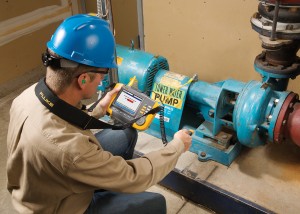
What’s shakin’ with your mechanical systems?
Most machines have rotating parts, and rotating parts vibrate. Measuring how and how much those parts vibrate can tell you a lot about the health of a machine. Whether it’s the rumble of worn bearings or the shaking, shimmying or thumping...
June 1, 2013 | By By Colin Plastow
 Photo: Fluke Electronics Canada
Photo: Fluke Electronics Canada 
Photo: Fluke Electronics Canada
Most machines have rotating parts, and rotating parts vibrate. Measuring how and how much those parts vibrate can tell you a lot about the health of a machine. Whether it’s the rumble of worn bearings or the shaking, shimmying or thumping of loose, misaligned or unbalanced parts, machines have a tale to tell to those who are willing and able to listen.
Vibration analysis — the art and science of measuring and interpreting those tell-tale rumbles and shakes — has been around for decades, but mostly in the domain of specialists operating exotic instruments for corporations and government agencies with mission-critical equipment and very deep pockets.
For everyone else, vibration analysis was typically performed by a mechanic using a makeshift stethoscope fashioned from a screwdriver — the tip held to the machine, the handle held to the ear — or, more often, not done at all. Recent developments however, are making vibration analysis cheaper, easier, and more widely available.
Common mechanical faults revealed
Measuring the vibrations of motors, pumps, and other common machines can reveal valuable information about machine health — or impending failures. Easier measurement procedures combined with automated vibration analysis enables personnel with minimal training and experience to use vibration to evaluate machine health and determine required maintenance.
Vibration analysis can reveal four of the most common mechanical faults.
• Imbalance – A ‘heavy spot’ in a rotating component causes vibration when the unbalanced weight rotates around the machine’s axis, creating a centrifugal force. As machine speed increases, the effects of imbalance become greater. Imbalance can severely reduce bearing life as well as cause undue machine vibration.
• Misalignment/shaft runout – Vibration can result when machine shafts are out of line. Angular misalignment occurs when the axes of (for example) a motor and pump are not parallel. When the axes are parallel but not exactly aligned, the condition is known as parallel misalignment. Misalignment may happen during assembly or develop over time, due to thermal expansion, components shifting, or improper reassembly after maintenance. The resulting vibrations may be in the direction of the rotation, along the shaft axis, or both.
• Wear – As components such as bearings, drive belts or gears become worn, they may cause vibration. When a roller bearing race becomes pitted, for instance, the bearing rollers will cause a vibration each time they travel over the damaged area. A gear tooth that is heavily chipped or worn, or a drive belt that is breaking down, can also produce vibration.
• Looseness – Vibration that might otherwise go unnoticed may become obvious and destructive if the component that is vibrating has loose bearings or is loosely attached to its mounts. Such looseness may or may not be caused by the underlying vibration. Whatever its cause, looseness can allow any vibration present to cause damage, such as further bearing wear, or wear and fatigue in equipment mounts and other components.
How to measure vibration
Vibration sensors have advanced far beyond the mechanic’s screwdriver. There are a variety of sensor types, but the accelerometer is the most common. To take a measurement, a small metal sensor is attached to the appropriate location on the equipment to be tested.
The attachment, which can be permanent for continuous monitoring or temporary for machines that are evaluated only periodically, must be at a position on the machine that reveals the best information about the vibration that is being investigated (at the bearings of a motor, for example, or close to a rotating shaft).
Inside the sensor, an array of tiny electronic accelerometers convert movement along any of the three axes (up and down, back and forth, side to side) into an electrical signal that is fed to a recording device. Recorded vibration data can be analyzed at the test site for an immediate diagnosis, and can also be saved for later analysis or comparison with earlier recordings to monitor trends in machine health.
Benefits of vibration analysis
Predictability – Vibration analysis can provide early warnings of impending machine failure, giving maintenance staff time to schedule required repairs and acquire needed parts.
Safety – Having information about machine health enables operators to take faulty equipment offline before a hazardous condition occurs.
Revenue – Well-maintained machines have fewer unexpected and serious failures, helping to prevent production stoppages that cut into the bottom line.
Increased maintenance intervals – When machine health is being tracked, maintenance can be scheduled by need, not just by accumulated hours of operation.
Reliability – Monitored machinery has fewer unexpected or catastrophic failures.
Cost savings – Running machinery until failure often results in more expensive repairs, overtime, and forced purchases.
‘Run to failure’ maintenance programs, while simple, often have costlier repairs, loss of revenue from production stoppages, and expensive overtime.
Preventive maintenance programs, in which machinery is serviced after a certain number of hours of operation, can result in unnecessary work being performed, and unmonitored machinery can still fail before the maintenance interval elapses. When vibration analysis is incorporated into a maintenance program, however, the condition of monitored machines is known, so unnecessary maintenance work is avoided, and required work can be scheduled for convenient times and when parts are available.
Advances in vibration sensor, data acquisition and analysis technologies have enabled the introduction of powerful, portable, affordable, easy-to-use vibration measurement and analysis tools that enable even smaller organizations with limited training and hardware budgets to enjoy the considerable benefits of vibration analysis. MRO
Colin Plastow is the industrial product manager for Fluke Electronics Canada. He has been with the company since 1987 in various support and product management positions. He can be contacted by e-mail at colin.plastow@fluke.com.
Online Reader Inquiry No. 500
